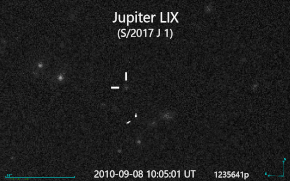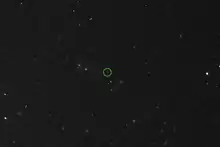 Precovery images of Jupiter LIX taken by the Canada–France–Hawaii Telescope in 2010 | |
| Discovery | |
|---|---|
| Discovered by | Scott S. Sheppard et al. |
| Discovery date | 5 June 2017 |
| Designations | |
Designation | Jupiter LIX |
| S/2017 J 1 | |
| Orbital characteristics [1] | |
| 23547105 km | |
| Eccentricity | 0.397 |
| −734.2 days | |
| Inclination | 149.2° |
| Satellite of | Jupiter |
| Group | Pasiphae group |
| Physical characteristics | |
Mean diameter | 2 km |
| 23.8 | |
Jupiter LIX, provisionally known as S/2017 J 1, is an outer natural satellite of Jupiter on a retrograde orbit. It was reported on June 5, 2017, via a Minor Planet Electronic Circular from the Minor Planet Center.[2] It is believed to be about 2 km in diameter.[3]

Precovery image of Jupiter LIX on 8 September 2010 (circled)
It is a member of the Pasiphae group. It has an average orbital distance of 23,547,105 km, with an inclination of 149.2 degrees. Its period is 734.2 days.[4]
References
- ↑ S.S. Sheppard (2019), Moons of Jupiter, Carnegie Science, on line
- ↑ "MPEC 2017-L47 : S/2017 J 1". Minor Planet Center. International Astronomical Union. Retrieved 5 June 2017.
- ↑ "Jupiter Satellite Data". Archived from the original on 2017-07-20. Retrieved 2017-06-17.
- ↑ "Scott S. Sheppard - JupiterMoons".
This article is issued from Wikipedia. The text is licensed under Creative Commons - Attribution - Sharealike. Additional terms may apply for the media files.